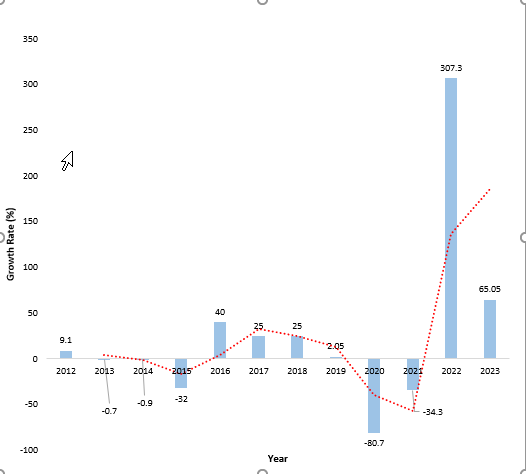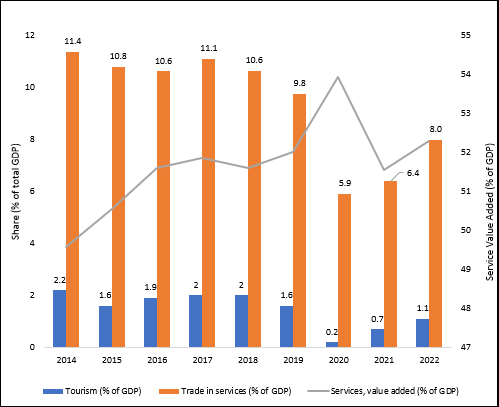Opinion in lead
Unveiling opportunities and addressing challenges of tourism in Nepal
Tourism has remained a vital part of the global economy. While tourism can generate enormous benefits to least developed countries like Nepal, setting up a thriving tourism industry is a challenging task. In 2023, Nepal’s sector generated US$2.5 billion in revenue and supported 1.19 million jobs directly and indirectly, and the forecast for 2024 is 1.22 million jobs (15.2 percent of total employment).

Nepal holds tremendous potential to reap rich dividends from the worldwide flourishing of tourism. Nepal’s geography allows tourists access to the Himalayas and the presence of significant religious and cultural heritage adds to Nepal’s allure. Similarly, Nepal could reap spillover benefits from more famous neighbours such as China and India. China and India are ranked 8th and 39th, respectively, in terms of popular tourist destinations in the Travel and Tourism Development Index 2024 by the World Economic Forum. In contrast, Nepal holds a much lower rank of 105, highlighting the enormous potential of increased connectivity to these countries.
Revamping tourism in Nepal has always been a key focus for the Government of Nepal, prompting the government to launch different campaigns. For example, 2020 was supposed to be the Visit Nepal year to attract 2 million tourists. However, this goal was put on hold due to the COVID-19 pandemic. The pandemic affected the tourism sector the most as the movement of people came to a halt. To revive tourism post-COVID, the government has designated the year 2025 as the Nepal Special Tourism Year and the period from 2023 to 2033 as the Visit Nepal Decade. motive behind these two initiatives is to invite around 3.5 million tourists annually, which is estimated to create 1 million jobs annually. Promotional efforts by various agencies—private and public—over the past few years have helped buoy up demand for travel, as evidenced by the annual growth rate of tourist arrivals in Nepal.

Tourists decide on destinations based on the attractions offered and their budget. Although Nepal is not an expensive destination as the average per visitor per day expense in 2023 was about US$41 only, limited direct air connectivity makes flights to Nepal expensive. The Tribhuvan International Airport (TIA) used to be the only international airport, leading to air traffic congestion and delays in flights. A study by the Civil Aviation Authority of Nepal (CAAN) expects air traffic to reduce by 30 percent after two newly constructed airports (Bhairahawa and Pokhara airports) come into full operation. However, the operation of these two airports is mired in uncertainty. Due to the European Union Aviation Safety Agency’s ban on Nepali airlines, air connectivity to Nepal is highly dependent on other international air carriers. This also prevents Nepal from offering cheaper and easily accessible flights. A flight to Nepal can be up to 70 percent more expensive than one to India.
Not that Nepal performs better on other aspects of transport infrastructure. A report published by the World Economic Forum states that the air transport infrastructure score of Nepal for 2024 is 2.07 out of 7 (the mean score for South Asia is 3.35) and the tourist service and infrastructure score of Nepal is 1.35 out of 7 (the mean score of South Asia is 1.51), making it the worst-performing nation among its South Asian counterparts on both parameters.
Meanwhile, the Ministry of Tourism and Civil Aviation declared an ambitious Tourism Decade beginning in 2023, aiming for an annual arrival of 3.5 million tourists. As a result, the private sector has made significant investments in Nepal’s tourism industry. Nepal is still dependent on backpacking tourists that spend less money. Hence, despite the increase in tourist numbers, there has not been a corresponding rise in their expenditures. This underscores the need to diversify tourism offerings and services to attract affluent travellers who are likely to spend more generously during their time in Nepal.
Attracting high-end tourists who spend more money requires matching infrastructure that ensures comfort, safety and luxury to tourists. More needs to be done to encourage tourists to make their trips longer. At present, the average tourist stay is 13.2 days, a portion of which could be attributed to tourists who come to Nepal for trekking and mountaineering purposes. Nepal lacks amenities and attractions to cater to tourists who are not looking for adventure. Nepal lags behind its rivals in infrastructure, hotels, new destinations, accessible facilities for special needy people, aviation (e.g., unreliable domestic air services), and public investment. In addition, Nepal performs poorly in scientific international tourism marketing by national institutions, where the technological burst across the tourism industry is not taken into consideration. Similarly, a lack of coordination between major stakeholders has led to Nepal failing to tap its full potential.
Nepal Trade Integration Strategy (NTIS) 2023 has identified tourism (including leisure, business, education, and medical) as one of the potential areas in the services sector. NTIS 2023 recommends encouraging domestic tourism, allowing the private sector to manage airports, and enhancing skills in hospitality, among other measures, to support tourism. Some reports suggest Nepal promote green tourism for the recovery and resilience of tourism in Nepal. Tapping into tourists coming to visit China and India is another key avenue where tourism promotion could be crucial.
Nepal’s comparative advantage in nature-based tourism lies in its extensive network of protected areas. By developing high-value tourism offerings and enhancing infrastructure, Nepal can maximize the developmental benefits of tourism. To fully capitalize on tourism, Nepal must clearly define the type and number of tourists it aims to attract and accommodate. All stakeholders, including the often-overlooked Nepali diaspora, should collaborate to ensure the holistic development of tourism. Together, they can showcase Nepal’s rich offerings to the world.
Ms Adhikary is an intern at SAWTEE. This article was published in Trade, Climate Change and Development Monitor, Volume 21, Issue 06, June 2024.
